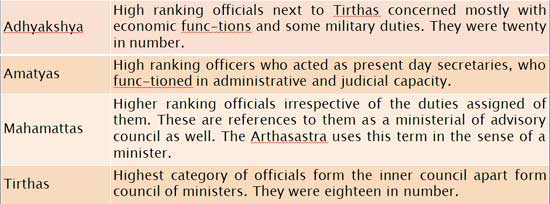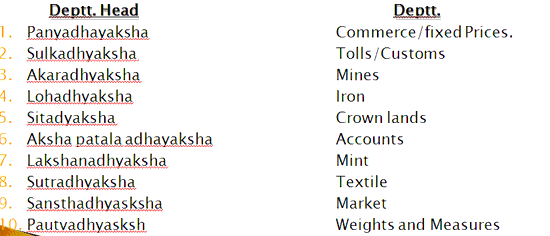(HOT) UPSC Current Affairs 2025 PDF
NEW! The Gist (NOV-2025) | E-BOOKS
(IGP) GS Paper 1 - History of India & Indian National Movement - "The Mauryan"
Integrated Guidance Programme of General Studies for IAS (Pre) - 2013
Subject - History of India & Indian
National Movement
Chapter : The Mauryan
References and Sources:
The most important source in Artha Sastra which has 15 chapters called Adhikaranas. Other Sanskrit sources are Kaumudi Mahotsava of Vajika and Mudraraksha of Visakhadutta. Sangam poets named Mamulnar and Pamar described about Bimba Mauryas attack on South India.
- Division of Indian Society into seven castes – Megasthenes
- Absence of slavery – Megasthenes
- Chronology and list of Mauryan Kings – Puranas
- Economic and Political Conditions – Arthashastra
- Social and Economic Conditions – Jatakas
- Role of Ashoka in spreading Buddhism to Sri Lanka - Dipvamsa & Mahavamsa
- Conversion of Chandragupta Parisistparvan of Maurya to Jainism — his abdication of throne and going to Sravanbelagola –Hemachandra
- Absence of usury (Money lending) – Megasthenes
- Ashoka’s favour to Ajivikas - Barabar Hill cave inscriptions
- Construction of Sudarsana Lake - Junagarh Rock Inscription of Rudraman I.
- Killing of 99 of his brothers and seizing of throne by Ashoka Mahavamsa & Dipavamsa
- The name Ashoka - Maski Gujarra, Nittur and Udegolam Edicts
- Existance of an Ashokan Pillar at Sanakisa with a lion capital – Fahien
- The Mauryan army is band of dacoits – Justin
- Jaluka was the successor of Ashoka in Kashmir - Rajataringini
For Detail Description, Analysis and More MCQs of the Chapter Buy this Study Notes:
Central Administration:

Administrative Divisions and Officers Associated with them:
Province
- Kumara (Governors, title given to Sons of king).
- Aryaputra (Governors, title given to persons of royal blood, usually king’s relatives).
District
- Pradesikas (head of the district, looked after law & order and revenue collection.
- Raj juka (looked after rural administration and justice).
Group of Villages
- Sthanika (looked after tax collection).
- Gopa (Accountant).
Village
- Gramika (Village headman).
Provinces during the Mauryan Age:
- Uttarapatha Taxila
- Dakshinapatha Suvarngiri
- Prachaya Patliputra
- Kalinga Tosali
- Avantiratha Ujjain

Army:
- Plutarch and Justin have described about Chandraguptas army.
- Size and organisation of army was fairly large.
- According to Pliny it comprised 60000 infantry, 30000 cavalry, and 10000 elephants.
- According to Plutarch it consisted of 20000 infantry, 80000 horses, 6000 elephants and 8000 war chariots.
- Chanakya refers to Chaturangbala comprising infantry, cavalry, chariots and elephants as the principal organs of the army.
- Army administration was run by six committees (according to Megasthenes).
City Administration:
- Megasthanese has given prohific information on Municipal adminis-tration of pataliputra whIch was devided in to 30 words.
- Run by a city council known as Astyanomi
- City council consist of six sub-councils/committees
- Each committee had five members.
- Each committee was entrusted with a particular work namely:
- First Committee - Industry & crafts
- Second Committee - Foreigners
- Third Committee - Registration of births & deaths
- Fourth Committee - Trade & commerce, weights & measures
Taxes:
- Sita-Crowniand
- Bhag-Land tax — 1/6
- Bali-Voluntary offering
- Vastu-Tax taken from rural areas
- Durg-Tax taken from urban areas
- Kara — Orchard tax
- Vivit-Tax imposed on pasture land
Facts about Ashokan Edicts & Inscriptions:
- Maski Gujarra, Nittur and Odegolam edicts mention the name Ashoka
- Ashokan edicts were deciphered by James Princep in 1837.
- The Topra & Meerut Pillars were brought to Delhi by Firoz Shah Tughlaq.
- The Kausambi Pillar was brought to Allahabad by Jehangir.
- The Bairat inscription was brought to Calcutta by Cunningham.
- The major rock edicts at Manshera & Shahbazgarhi are in Kharoshthi script.
- The Kandahar inscription is bilingual written in Greek & Armenic.
- Most of the Ashokan edicts are written in Brahmi script.
- The language used in Ashokan edicts except Kandhar is Prakrit.
- The inscription in fragmentary condition found at Lampaka/Lamghan is in Aramaic.
Major Pillar Edicts:
- Contents— These are appendix to rock edicts.
- Location — 1. Allahabad (UP) 2. Delhi Topra (Punjab) 3. Delhi-Merritt (UP) 4. Lauriya Areraj (Bihar) 5. Lauriya Nandangarh (Bihar) 6. Rampurva (Bihar)
Kalinga Edicts:
- Contents — System of administration in Kalinga
- Location — 1. Dhauli (Orissa) 2. Jaugada (Orissa)
Bhabru Edicts
- Contents — Ashoka’s conversion to Buddhism and his reverence for his religion
- Location — Calcutta (WB) brought from Bairat (Rajasthan)
Foreign Emissary/Ambassador In The Muryan Court
- Megasthenes — by Seleucus to the court of Chandragupta Mauryas
- Deimachos — by Antiochus I, King of Syria - to the court of Bindusar
- Dionysios — by Ptolemy II - to the court of Bindusar
Animal Capitals Surmounting The Ashoka Pillars
- Ranipurva I Single Lion
- Laurya-Nandangarh Single Lion
- Basarah (Vaishali) Single Lion
- Rampurva II Single Bull
- Sarnath Four Lions
- Sanchi Four Lions
- Sankisa Single Elephant
Religious Belief of The Mauryas
- Chandragupta Jainism (According to Bhadrabahucharit)
- Bindusar Ajivikas
- Ashoka Buddhism (according to Kaihan)
- Dasaratha Ajivikas
- Samprati Jain
For Detail Description, Analysis and More MCQs of the Chapter Buy this Study Notes:

